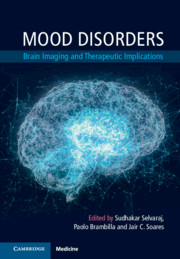Book contents
- Mood Disorders
- Mood Disorders
- Copyright page
- Contents
- Contributors
- Preface
- Section 1 General
- Section 2 Anatomical Studies
- Section 3 Functional and Neurochemical Brain Studies
- Section 4 Novel Approaches in Brain Imaging
- Section 5 Therapeutic Applications of Neuroimaging in Mood Disorders
- Chapter 17 Effects of Lithium on Brain Structure in Bipolar Disorder
- Chapter 18 Molecular Imaging of Dopamine and Antipsychotics in Bipolar Disorder
- Chapter 19 Brain Imaging and the Mechanisms of Antidepressant Action
- Chapter 20 Neuroimaging Studies of Effects of Psychotherapy in Depression
- Index
- Plate Section (PDF Only)
- References
Chapter 20 - Neuroimaging Studies of Effects of Psychotherapy in Depression
from Section 5 - Therapeutic Applications of Neuroimaging in Mood Disorders
Published online by Cambridge University Press: 12 January 2021
- Mood Disorders
- Mood Disorders
- Copyright page
- Contents
- Contributors
- Preface
- Section 1 General
- Section 2 Anatomical Studies
- Section 3 Functional and Neurochemical Brain Studies
- Section 4 Novel Approaches in Brain Imaging
- Section 5 Therapeutic Applications of Neuroimaging in Mood Disorders
- Chapter 17 Effects of Lithium on Brain Structure in Bipolar Disorder
- Chapter 18 Molecular Imaging of Dopamine and Antipsychotics in Bipolar Disorder
- Chapter 19 Brain Imaging and the Mechanisms of Antidepressant Action
- Chapter 20 Neuroimaging Studies of Effects of Psychotherapy in Depression
- Index
- Plate Section (PDF Only)
- References
Summary
Depression is one of the leading causes of mortality, disability, and loss of productivity. The World Health Organization (WHO) ranks depressive disorders as the eleventh cause of disability and mortality (1, 2). The worldwide lifetime prevalence of depression is around 12% (3). In spite of the considerable burden of depression both in terms of prevalence and public health impact, the search for more effective treatments for depression is still ongoing. Emerging evidence suggests that personalizing treatments based on individuals’ biosignature could be the “way forward” (4).
- Type
- Chapter
- Information
- Mood DisordersBrain Imaging and Therapeutic Implications, pp. 261 - 272Publisher: Cambridge University PressPrint publication year: 2021
References
- 1
- Cited by

